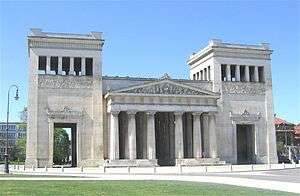Propylaea (Munich)
The Propylaea (German:Propyläen) is a city gate in Munich at the west side of Königsplatz.

History
The building constructed in Doric order was completed by Leo von Klenze in 1862 and evokes the monumental entrance of the Propylaea for the Athenian Acropolis. The gate was created as a memorial for the accession to the throne of Otto of Greece, a son of the principal King Ludwig I of Bavaria.

As early as 1816 it was already considered to build the Propylaea, but it took 30 years until the order was issued for this purpose. Klenze painted a picture before the construction of the Propylaea, to promote its project. As King Ludwig I had resigned in 1848, the project was called into question because Munich at that time did not need a gate anymore. Finally Ludwig I financed the building from his private resources as a sign of the friendship between Greece and Bavaria as well as a monument to the Greek War of Independence.[1]
The Propylaea was opened shortly before King Otto was forced to resign. While on a visit to the Peloponnese in 1862 a coup was launched in Greece, a provisional Government was set up and summoned a National Convention. Ambassadors of the Great Powers urged King Otto not to resist, and the king and queen took refuge on a British warship and returned to Bavaria. So the Propylaea have also become a monument for the failed secundogeniture of the Wittelsbach.
Architecture
Each of the two towers of the gate is a powerful block with a large portal and an open room upstairs. The two portals of the towers served to freight transport, the driving (as seen from the city) leaving the city was operated through the left gate, in the downtown of freight passed through the right gate. The monumental gate in the middle of the Propylaea was reserved for riders and city cars. The underside of the roofs of the towers was designed as a coffered ceiling. If somebody wanted to move between the towers, one would have to climb over the railing and proceed over the flat roof.
While the exterior shows Doric columns in the interior Ionic columns can be found to bear the rafters of the Propylaea. In addition, the floor plan shows as well as the section of the gatehouse, that the basement of the building could be traversed by stairs, platforms and passageways.
The neo-classical architects of that time knew already that Greek temples were colored. But unfortunately, it was unknown how they succeeded in ancient Greece, marble surfaces to be provided with bright colors. Leo von Klenze would give the building a magnificent colors jewelry, but he also found a solution for the application of the paint. So he planned instead the plastic decoration of the Propylaea. The reliefs and sculptures celebrating the Bavarian prince and the Greek War of Independence were created by Ludwig Michael Schwanthaler.
Notes
| Wikimedia Commons has media related to Propylaea (Munich). |
Coordinates: 48°08′46″N 11°33′51″E / 48.1461°N 11.5642°E